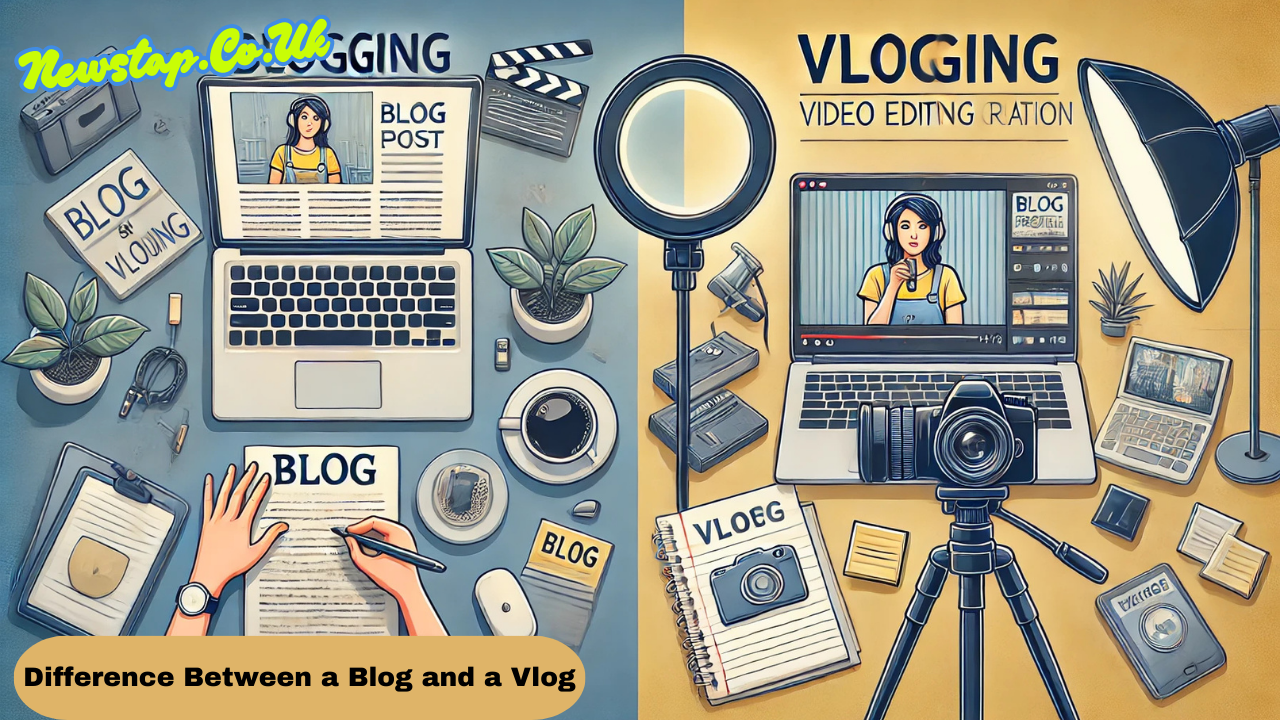Introduction
In the digital era, content creation has evolved into multiple forms, with blogging and vlogging emerging as two of the most popular mediums. While both are used to share information, opinions, and stories, they differ significantly in format, audience engagement, and monetization. Understanding the difference between a blog and a vlog is essential for anyone considering content creation as a career or hobby. This article delves deep into the key distinctions between blogging and vlogging, their advantages, challenges, and how they cater to different audiences.
What is a Blog?
A blog is a text-based content format that is published on a website. It consists of written articles or posts that can include images, infographics, and embedded videos. Blogs cover various topics, such as technology, travel, health, personal experiences, and business insights. Bloggers typically use platforms like WordPress, Blogger, and Medium to create and publish their content.
What is a Vlog?
A vlog, short for “video blog,” is a content format that primarily consists of video recordings. Vlogs are published on video-sharing platforms such as YouTube, TikTok, or Vimeo. Unlike traditional blogs, vlogs rely heavily on visual storytelling, where creators present their content through video recordings, often incorporating music, effects, and animations to engage viewers.
Key Differences Between a Blog and a Vlog
1. Content Format
- A blog is primarily text-based, often accompanied by images, charts, and links.
- A vlog is video-based, where creators communicate through spoken words, visual storytelling, and graphics.
2. Ease of Creation
- Blogs require strong writing skills, research, and SEO optimization for better reach.
- Vlogs need video recording equipment, editing software, and presentation skills to engage audiences effectively.
3. Audience Engagement
- Blogs encourage readers to engage through comments, shares, and discussions.
- Vlogs allow for more direct interaction, as viewers can leave comments, like videos, and respond to the creator’s expressions and tone.
4. Monetization Options
- Bloggers earn through ad placements, affiliate marketing, sponsored content, and memberships.
- Vloggers generate revenue through YouTube ads, brand collaborations, merchandise, and crowdfunding.
5. SEO and Discoverability
- Blog posts require search engine optimization (SEO) strategies such as keyword optimization and backlinks to rank well on Google.
- Vlogs rely on YouTube SEO, including video titles, descriptions, thumbnails, and engagement metrics like watch time and likes.
6. Equipment and Investment
- Blogging requires minimal investment, mainly a laptop, a website, and writing tools.
- Vlogging demands a good camera, microphone, editing software, and sometimes lighting setups.
7. Time and Effort
- Writing a blog post may take several hours, including research, writing, proofreading, and formatting.
- Creating a vlog involves shooting footage, editing, adding effects, and optimizing for social media, making it more time-consuming.
Advantages of Blogging
- Low Entry Barrier: Blogging requires only a basic understanding of writing and website management.
- SEO Benefits: Well-optimized blogs rank high on search engines and drive organic traffic over time.
- Evergreen Content: Well-written blog posts remain relevant for years and continue to attract readers.
- Passive Income Potential: Through ads, affiliate marketing, and eBooks, bloggers can earn long-term revenue.
- Flexibility: Blogging allows creators to work at their own pace, unlike vlogging, which requires on-camera presence.
Advantages of Vlogging
- Visual Appeal: Vlogs create a more personal connection through facial expressions and emotions.
- High Engagement: Videos tend to attract more interaction, shares, and comments compared to text.
- Platform Growth: Video content is widely consumed, leading to exponential growth on platforms like YouTube and TikTok.
- Monetization Opportunities: With YouTube AdSense and brand partnerships, vloggers can make significant income.
- Authenticity: Vlogs allow creators to showcase their real personalities, making content more relatable.
Challenges of Blogging vs. Vlogging
Blogging Challenges:
- Requires strong writing skills and consistency.
- SEO competition can be tough, making it hard to rank high.
- Lower engagement compared to video content.
Vlogging Challenges:
- Video production requires time, effort, and investment.
- On-camera confidence is necessary for success.
- Editing and maintaining a video schedule can be challenging.
Which One Should You Choose: Blog or Vlog?
The decision between blogging and vlogging depends on personal preference, skills, and resources. If you enjoy writing and prefer a low-investment content strategy, blogging may be the right choice. However, if you are comfortable in front of a camera and enjoy video production, vlogging can be more rewarding.
Many successful content creators use a hybrid approach, combining both blogs and vlogs to maximize their reach. For instance, a blogger can embed videos within their articles to enhance engagement, while a vlogger can maintain a website for additional written content.
Conclusion
The difference between a blog and a vlog lies in their content format, creation process, audience engagement, and monetization potential. While blogs rely on written content and SEO strategies, vlogs use video storytelling and social media engagement. Both have their unique advantages and challenges, making them suitable for different types of content creators. Ultimately, the choice between blogging and vlogging depends on your strengths, interests, and long-term goals in the digital space.
Also Read: The Blog Snapsourcenet: Exploring the Essence of Digital Storytelling and Beyond



